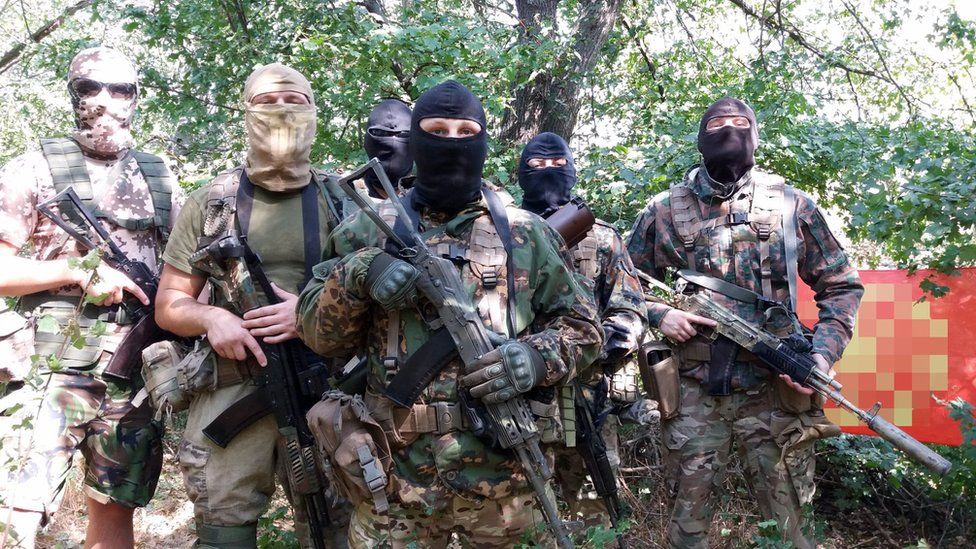- fake ISIS pro-Ukrainian volunteers;
- bogus Ukrainian Azov fighters threatening the Dutch;
- fake pro-Russian guerillas in free Ukrainian cities;
- sham pro-Ukrainian Russian terrorists.
As well, it discloses connections between:
- the mentioned fake video stories, some of which were filmed in the occupied eastern-Ukrainian city of Donetsk;
- anti-Ukrainian hacker group Cyber-Berkut;
- Saint Petersburg 'troll factory.'
Here we publish the summary of BBC's original article in Russian.
Masked faces, distorted voices, poses from action movies and ready-to-use firearms - the Russian-language Internet is full of videos showing the threat coming from radical groups. They can call themselves pro-Russian guerillas in Ukraine, pro-Ukrainian guerillas in Russia and even ISIS fighters, but it is sometimes hard to take no notice of the similarity between them.
Faking stories and instigating conflicts, the same methods used by the Saint Petersburg "troll factory" to influence the American election, have been piloting on the Russian-speaking audience for years. The troll factory is helped by the so-called "ministry of state security of the Donetsk People's Republic" ("DNR") and by the propaganda franchise Cyber-Berkut, an anti-Ukrainian hacker group.
Fake "Russian Liberation Movement"
On 23 August 2017, when Govnyarka, a residential neighborhood in the center of Rostov-on-Don, was still cindering, set to fire by unknown persons, the first video emerged on behalf of the so-called "Russian Liberation movement" (ROD).
The six armed men with a neo-Pagan flag called themselves Russian nationalists who helped Ukrainians to fight the "bloody Putin regime" in eastern Ukraine. They stated to have "directed their eyes at their own fatherland."
In their next record, the "ROD brothers-in-arms" claimed the Rostov arson their "first successful terror attack on the territory of the Russian Federation." Later they taught how to seize buildings and set up booby traps, they put a pig head on the Quran sending regards to strongman Ramzan Kadyrov, the pro-Kremlin leader of the mostly Muslim Russian republic of Chechnya.

In one of their videos, the alleged guerillas referred to Dobroslav, a callsign for Alexei Dobrovosky, the leader of a Russian neo-Pagan movement who had died in 2013. In the next footage, they quoted surahs and ayahs from the Quran to abuse Muslims. Overall, they did their homework and made no silly mistakes like the fake ISIS fighters who claimed to be members of Ukrainian volunteer battalion Azov while filming their video at a well-known location in occupied Donetsk, uncontrolled by the Ukrainian government.
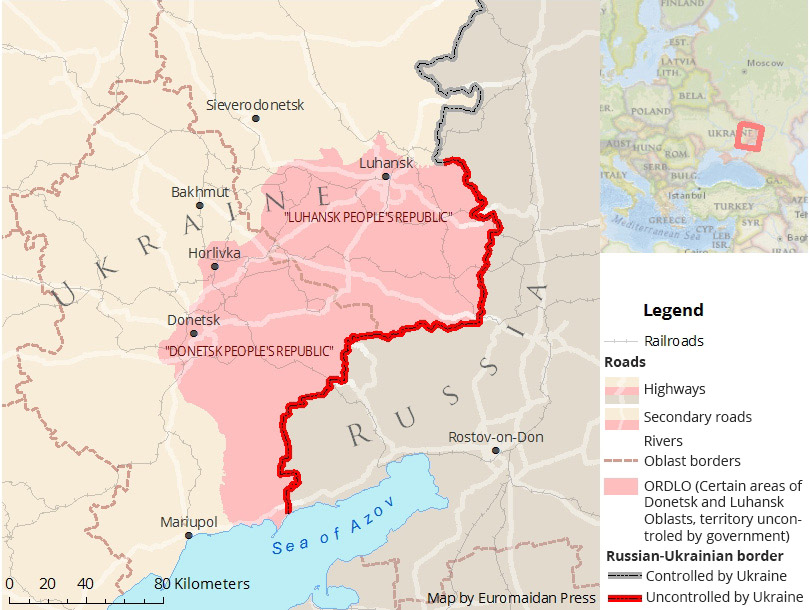
But ROD's campaign failed. The videos were spread via Youtube and seven fake profiles on vk.com (Russian Facebook-like social media). Youtube deleted ROD's videos before they exceeded 1,000 views, and even Russian state-run media were skeptic about the ROD movement.
Creator of the "Russian Liberation Movement"
The investigation of Andrey Soshnikov reveals that the person behind the fake pro-Ukrainian guerillas is Ivan Borozenny, a former Ukrainian police officer from Kerch, now occupied Crimea, who was a member of the National Liberation Movement (NLM), a Russian pro-Putin nationalist political force. Borozenny opposed the Euromaidan revolution, amid which he decided to rename himself as "Daliant Maksimus, Duke of Goths" while studying at the police academy in Kharkiv, located in north-eastern Ukraine. Borozenny took an active part in Russia's annexation of Crimea and appeared on Russian federal TV channels.
Later Borozenny founded "The Center for Strategic Initiatives of Novorossiya" and remains its only known employee. He coded a website for the so-called ministry of the state security (MGB) of the "DNR" where his Center was credited in the source code. Borozenny also films videos for the MGB and publishes some of them on his vk.com and Youtube channels before the MGB publishes them on theirs.
Parts of one of such videos, a promo of the MGB spetsnaz special unit, were filmed on the premises of Izolyatsia, formerly Donetsk art center. Earlier, the same location was picked for filming the fake video about ISIS fighters in the ranks of Ukrainian Azov battalion, which was published on behalf of the hacker group Cyber-Berkut.
Read also: Displaced art. The IZOLYATSIA art center, having fled occupied Donetsk, flourishes in Kyiv
The MGB promo uses the soundtrack from the video game Quake, which is also heard in video addresses by Cyber-Berkut, featuring Borozenny as both narrator and director. However, "Duke of Goths" is not credited and his face is hidden under a knight's helmet.
Borozenny issues pathetic addresses to Ukrainian law enforcers, where he asks them whether they like to live "under the Jewish occupation." Another video directly calls Cyber-Berkut a unit of the "DNR ministry of internal affairs (MVD)." It is an indirect evidence that the hacking group is under the same command as the law enforcement "ministry" of the Russian proxy republic in eastern Ukraine. For its part, the MGB spokesperson stated that documents and other information published by Cyber-Berkut were genuine.
Read more on the Donetsk MGB and MVD: Who is who in the Kremlin proxy “Donetsk People’s Republic”
The channels spreading Borozenny's addresses also publish other videos featuring masked men who call themselves pro-Russian separatist "partisans" from the Ukrainian cities of Kharkiv, Dnipro, Zaporizhzhia, and Odesa, all under the control of the Ukrainian government. The videos use the same computer template of a flickering flag as their splash screens. [Editor's note: Russian propaganda has promoted these supposedly indigenous separatist movements in Ukrainian regions after the takeover of Crimea and beginning of the war in Donbas. They range in realism, with like the Kharkiv Partisans claiming to have carried out terror attacks, to other like the "Assembly of Romanians of Bukovyna" appearing to exist entirely for the sake of creating the visibility to the existence of a wide opposition to the Ukrainian government within Ukraine].
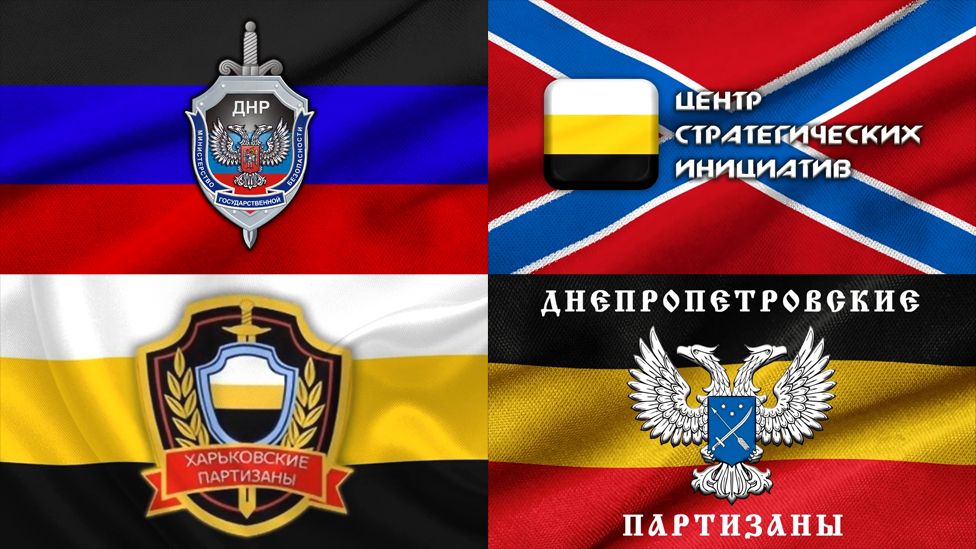
Read more: The Kremlin’s other separatist projects in Ukraine
What's in common between videos of fake Azov's ISIS, ROD and CyberBerkut?
The MGB's bogus ISIS Azov fighters and ROD terrorists have one more common feature besides masks, "saber-rattling" and threatening: all videos are searchable by Киберберкут ("Cyber-Berkut") hashtag.
In 2016, investigative search network Bellingcat debunked a video showing six men holding assault rifles who threatened the citizens the Netherlands on behalf of Ukraine's Azov battalion. Bellingcat related this video to the infamous Russian “St. Petersburg Troll Factories”
of the Russia's Internet Research Agency. One of the persons spreading the Dutch Azov fake was Yuri Gorchakov, according to Bellingcat. Soshnikov says that Gorchakov was a member of the Crimean NLM together with Diliant Maksimus (Ivan Borozenny) in 2014.
All mentioned videos show faces in masks ("ROD", "ISIS", "guerillas", the Netherlands), but the faces are not masked so tight to miss their matches. Thus, the "ISIS" holder of an AK-74 assault rifle with suppressor and laser target marker has a "twin brother" in ROD, one more twin of theirs joined "Kharkiv guerillas," another signed up with "Dnipro underground."

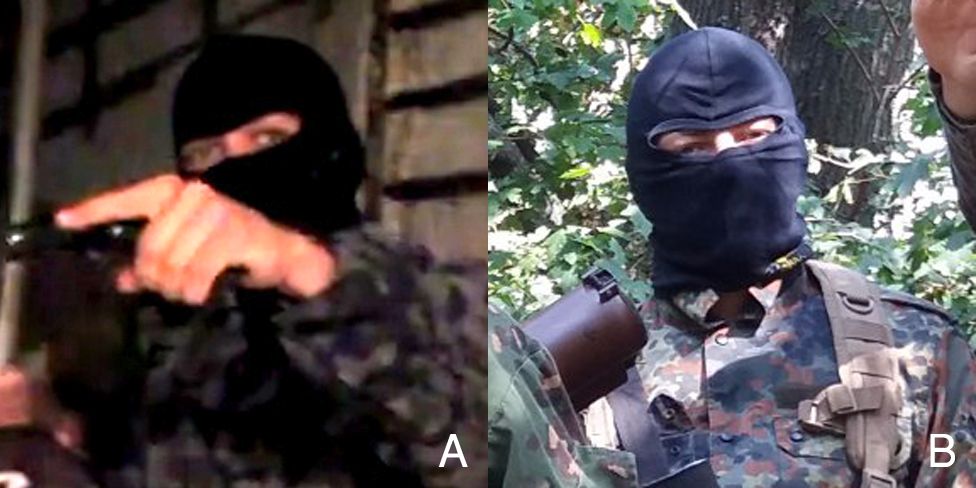
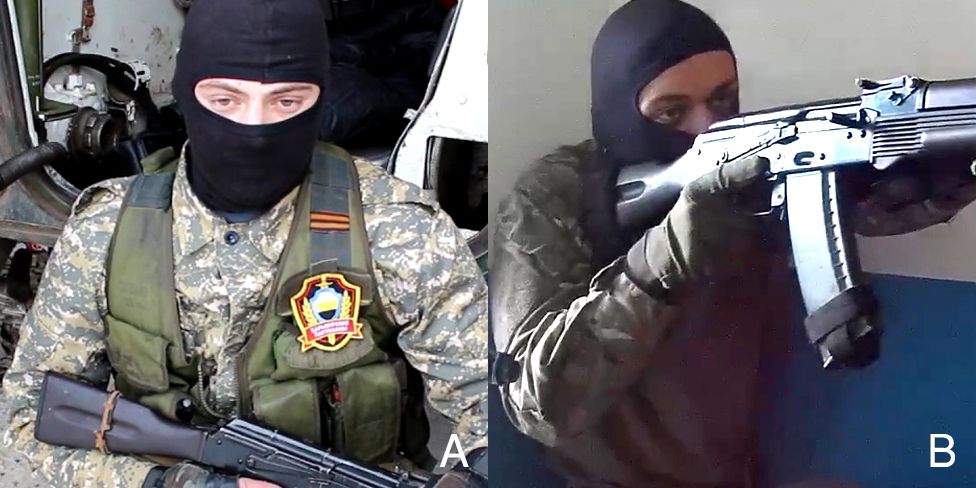

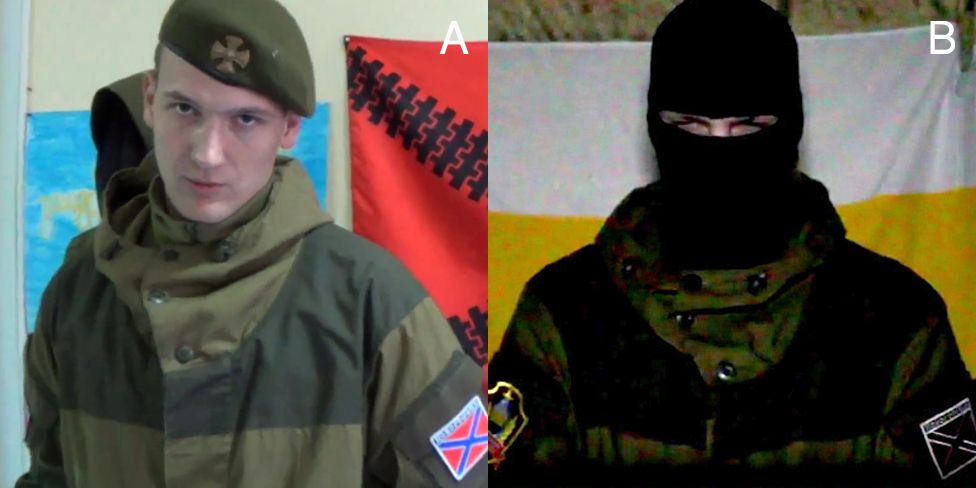
"Troll Factory"
The BBC investigation finds that Zulfar Asmandiyarov, working for the "troll factory" in Saint Petersburg, has taken an active part in spreading the ROD videos via social networks. Andrey Soshnikov used social engineering methods to identify this person behind several accounts on Twitter, vk.com, and Telegram.
Read also: Kremlin trolls exposed: Russia’s information war against Ukraine
The St.Petersburg-based troll factory was behind a few Cyber-Berkut fakes. In April 2016, they published a doctored video showing winking Vladimir Putin on a digital screen at New York's Times Square. Cyber-Berkut has been creating fake videos showing ostensibly hacked screens since 2014, yet they feature Kyiv instead of New York and commercials are replaced with messages about "military crimes of the [Kyiv] junta."
Sometimes the troll factory films their fakes on its own not resorting to services of the Donetsk extras. A string of fake videos against media projects by a Russian opposition leader Mikhail Khodarkovsky was made in 2016 in Saint Petersburg.
Read the full story "Masquerade show: how DNR special services and 'troll factory' threaten Russians with terror attacks" by Andrey Soshnikov (in Russian)
Read more:
- Whatever happened to the Kharkiv Partisans?
- The Kremlin’s other separatist projects in Ukraine
- Kremlin trolls exposed: Russia’s information war against Ukraine
- Russian trolls terrorize the West with old KGB methods
- Fake #2: Azov battalion threatens the Netherlands with terror attack
- ‘Kremlin’s G-20 photo fake to make Putin look important’
- Twitter’s new policy misused by pro-Kremlin accounts to block Ukrainian bloggers
- “Unprofessional slander.” Ukrainian rocket experts slam NYT accusations of North Korean leak
- Trolls on tour: how Kremlin money buys Western journalists
- Ukraine targeted by disinformation campaign to restore “friendship” with Russia
- How Russian TV-channels promote pro-Kremlin narratives in talk shows
- Inside RT and Sputnik: What is it like to work for Kremlin’s propaganda media?
- Eurovision, Russia, and weaponized disability
- Conspiracy: The US creates bioweapons in 400 countries (there are only 195)
- Media in Russian-occupied Donbas increasingly like those of North Korea, study finds
- The sad life of Putin’s “Troll Army”

